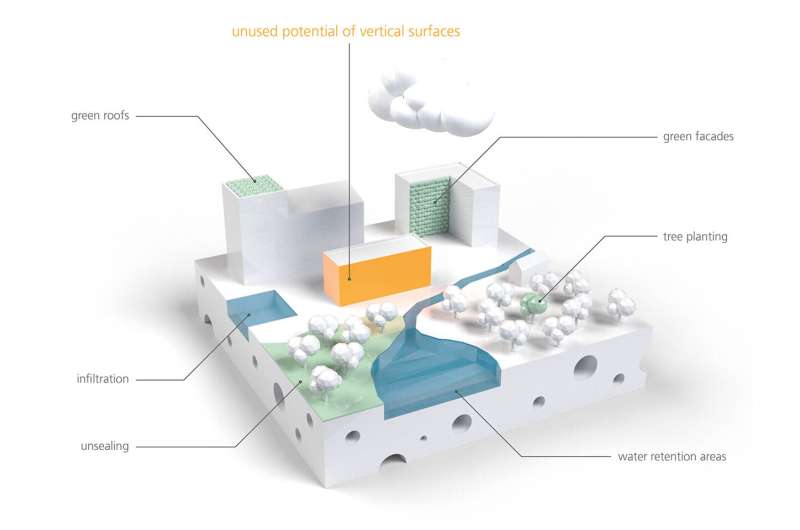This article has been reviewed according to Science X's editorial process and policies. Editors have highlighted the following attributes while ensuring the content's credibility:
fact-checked
trusted source
proofread
Resource-saving glass-foil roofing and vertical water retention system

In the "Light-Light-Roof" project, researchers at Fraunhofer UMSICHT developed foil-based materials to cover roofs in a light-transmissive manner. Roofs made of glass are often heavy and consume many resources—they consist of several panes of insulating glass.
The lightweight and modular lightweight system is a combination of a glass-foil modular system and an inner roof made of mobile, translucent and IR-reflective fabric. This saves around 75% material weight, which has a positive effect on the overall construction, material transport and assembly.
Demonstration of the glass-foil roofs in the Altmarktgarten Oberhausen
The modular system consists of an ETFE film covering (EFTE: ethylene-tetrafluoroethylene copolymer) and single-pane safety glass. ETFE allows up to 95% of the light to pass through. With circulating air between the glass pane and the film, the system can ideally interconnect with the building air—for example, in winter by defrosting snow or ice loads or for thermal insulation.
The IR-reflective fabric of the interior roof can also be adjusted as needed: For this purpose, the researchers are developing a measurement, control and regulation technology adapted to the building and user requirements, which will be integrated into the system. In the "Altmarktgarten Oberhausen" rooftop greenhouse, the researchers are currently testing the glass-foil system under real operating conditions in year-round operation.
Vertical water retention systems
Cities with heavily sealed surfaces in particular need new measures against heavy rainfall events, floods or heat waves to adapt to the climate change. The term "sponge city" covers a wide range of measures such as unsealing of surfaces, creation of green spaces, green roofs or tree locations. Vertical water retention systems are a valuable addition here to avoid peak loads in the sewer system and subsequently counteract local flooding. The goal is to absorb and store rainwater where it occurs instead of channeling and draining it away.
Fraunhofer UMSICHT is currently developing the concept "Vertical Water Sponge", a vertical retention system consisting of a load-bearing, permeable outer shell with a water-storing core made of mineral materials. Ideally, mineral materials from recycling processes such as bricks, sand-lime bricks, aerated concrete, which have very good water storage and conduction properties, are used for the core.
These modules are coupled to the roof drainage system, so that rainwater is fed directly into the modules. This allows large amounts of rainwater to be temporarily stored and then used in turn for evaporative cooling. The vertical retention modules are intended to be applicable to existing buildings and new construction.
"We are currently carrying out practical investigations into the conceptual design and development of functional samples of the modules with the aim of completing and testing a demonstrator on an application-oriented scale this year," explains Holger Wack, Product Development Department at Fraunhofer UMSICHT.
















